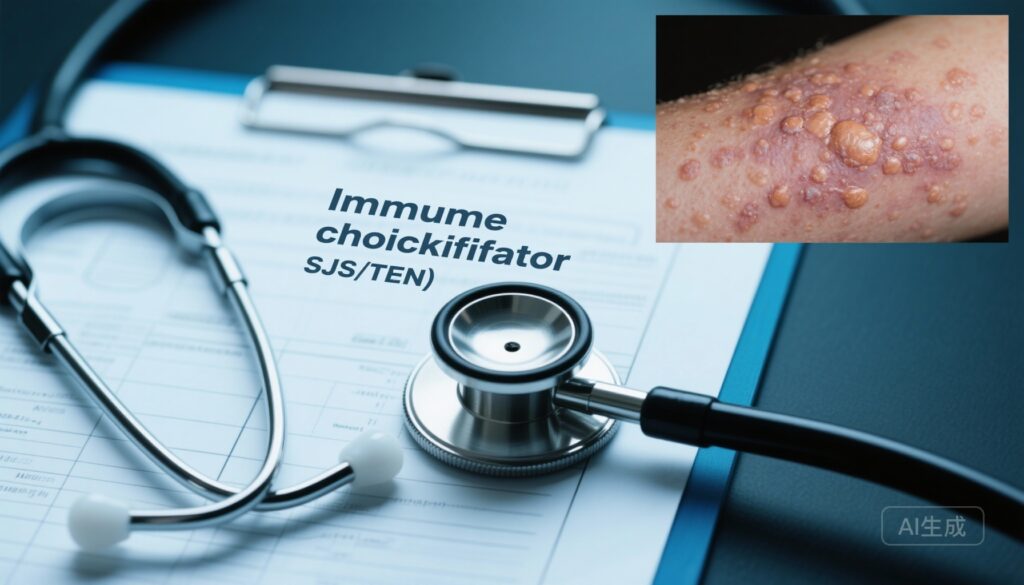Highlight
– A 2013–2023 FAERS analysis of nearly 14 million reports found immune checkpoint inhibitor (ICI) exposure independently associated with markedly higher odds of Stevens‑Johnson syndrome/toxic epidermal necrolysis (SJS/TEN) (aOR 9.14; 95% CI 8.42–9.93).
– Co‑exposure to established high‑risk drugs (eg, allopurinol, sulfonamides) and ICIs showed additive/supra‑additive interaction (attributable proportion [AP] 0.38 for strong culprits; AP 0.52 for weaker culprits), supporting a two‑hit model.
– ICI‑associated SJS/TEN presented later than non‑ICI cases, most notably with PD‑1 inhibitors, consistent with prolonged immune activation and diagnostic challenges in oncology care.
Background
Stevens‑Johnson syndrome and toxic epidermal necrolysis (SJS/TEN) are rare, life‑threatening mucocutaneous reactions driven by cytotoxic immune responses to drugs or infections. Mortality remains high in TEN and survivors often have significant morbidity. Immune checkpoint inhibitors (ICIs) that target PD‑1, PD‑L1, CTLA‑4 and other inhibitory pathways have transformed oncology by unleashing antitumor immunity, but they also produce diverse immune‑related adverse events (irAEs), including dermatologic toxicities. Distinguishing classical, drug‑specific SJS/TEN from ICI‑related SJS/TEN‑like or lichenoid bullous eruptions is clinically challenging, and the interaction between ICIs and other drug triggers has been incompletely characterized. With expanding ICI use across tumor types and lines of therapy, clarifying their role in SJS/TEN risk, timing, and mechanisms is a pressing clinical need.
Study design and methods
Mukherjee et al. interrogated 13,986,839 deduplicated reports in the US Food and Drug Administration Adverse Event Reporting System (FAERS) from 2013–2023 to identify reports of SJS/TEN (n=17,495). The authors used multivariable logistic regression to evaluate associations between ICI exposure and SJS/TEN, adjusting for age (spline terms), sex, documented cancer diagnosis, polypharmacy (number of concomitant drugs), and exposure to defined strong (eg, lamotrigine; trimethoprim‑sulfamethoxazole; phenytoin; allopurinol; carbamazepine) and weak (selected macrolides, fluoroquinolones, acyclovir) culprit drugs. Interaction metrics — relative excess risk due to interaction (RERI), attributable proportion (AP), and synergy index — quantified additive/supra‑additive risk when ICIs co‑occurred with other culprits. Latency analyses used two Cox proportional hazards models: (1) a mechanism‑based model classifying the primary suspect (PS) agent by ICI mechanism, and (2) a time‑dependent model that updated dynamic exposure to PD‑1/PD‑L1, CTLA‑4, or LAG‑3 inhibitors. Models incorporated the same covariates and handled missing age by imputation. Additional analytic details were reported in supplementary methods.
Key findings
Independent association with SJS/TEN: In adjusted analysis, reports with any ICI listed had substantially higher odds of SJS/TEN compared with non‑ICI reports (adjusted odds ratio [aOR] 9.14; 95% CI 8.42–9.93; P < .001). As expected, exposure to predefined strong culprit drugs was the strongest independent predictor (aOR 14.31; 95% CI 13.77–14.87). Weaker culprits also retained independent associations (aOR 3.69; 95% CI 3.51–3.88).
Synergy with other drug culprits: Interaction analyses pointed to additive or supra‑additive effects. For patients co‑exposed to ICIs and strong culprits, AP was 0.38 (95% CI 0.22–0.50), indicating 38% of the risk among co‑exposed individuals was attributable to the interaction. For ICIs with weak culprits AP was higher (0.52; 95% CI 0.38–0.63), and the synergy index exceeded 1 for both categories, supporting more than simple multiplicative co‑occurrence. RERI values were positive and significant for both classes, consistent with additive excess risk beyond independent effects.
Latency and timing: Latency analyses showed that ICI‑associated SJS/TEN tended to occur later than non‑ICI cases. Median time to event for anti‑PD‑1 primary suspect reports was 27 days versus 13 days for non‑ICI culprits. In the time‑dependent Cox model, PD‑1 inhibitors were associated with a lower hazard of earlier onset (HR 0.82; 95% CI 0.72–0.94; P = .004), consistent with delayed presentation. The mechanism‑based model similarly showed delayed onset for PD‑1 inhibitors compared with non‑ICI drugs (HR 0.71; 95% CI 0.60–0.94; P < .001). Cancer diagnosis itself was inversely associated with risk (aOR 0.60; 95% CI 0.58–0.63) and with earlier onset (HR ≈ 0.78 in both models), perhaps reflecting reporting or diagnostic complexity in oncology populations.
Other observations and data quality signals: Some analytic outputs illuminated reporting artifacts: reports with missing or imputed age had substantially different odds; the category ‘sex not specified’ showed an atypically high association with SJS/TEN, likely reflecting variable reporting completeness in severe adverse events. The number of concomitant drugs per unit increase had an aOR slightly less than 1, an unexpected direction that may reflect collinearity, reporting thresholds, or confounding by indication.
Interpretation and mechanistic plausibility
These results strengthen the signal that ICIs are independent drivers of SJS/TEN risk and suggest they may act synergistically with drug‑specific immune triggers. Mechanistically, classical SJS/TEN is a CD8+ T‑cell–mediated cytotoxic process that, in many cases, depends on HLA‑restricted presentation of drug‑derived antigens (for example, HLA‑B*58:01 and allopurinol‑induced severe cutaneous adverse reactions). ICIs relieve inhibitory checkpoints on T cells, lowering activation thresholds and potentially enabling expansion and effector function of pre‑existing or newly primed drug‑specific T cells. This model fits a two‑hit hypothesis: (1) a high‑risk drug provides an HLA‑restricted antigenic stimulus; and (2) an ICI amplifies the cytotoxic T‑cell response, increasing the likelihood of fulminant mucocutaneous injury. The delayed onset with PD‑1 inhibitors may reflect sustained T‑cell activation, slower epitope spreading, gradual recruitment of tissue‑resident memory T cells, or other immunologic dynamics different from rapidly acting small‑molecule hypersensitivities.
Clinical implications
For oncologists, dermatologists, and acute care teams, the study yields several actionable points:
- Pre‑therapy medication reconciliation: Carefully review and, when feasible, avoid initiating or continuing high‑risk drugs (eg, allopurinol, sulfonamides, aromatic anticonvulsants) in temporal proximity to ICI initiation. For drugs with a known HLA association (eg, allopurinol and HLA‑B*58:01), adhere to existing pharmacogenomic guidance (HLA‑B*58:01 testing in at‑risk populations before starting allopurinol).
- Heightened vigilance for delayed reactions: Maintain a longer window of surveillance for severe cutaneous reactions after ICI exposure, especially with anti‑PD‑1 agents. In oncology clinics, educate patients and infusion nurses to report mucosal symptoms, blistering, or rapidly spreading skin lesions even weeks after starting therapy.
- Diagnostic caution and early specialist input: Differentiate true SJS/TEN from ICI‑related lichenoid or bullous eruptions, because management strategies and prognoses may differ. Early dermatology consultation and consideration of skin biopsy, along with burn‑unit transfer when indicated, remain essential.
- Coprescribing decisions: Where alternatives exist (eg, substituting lower‑risk agents for prophylaxis or infection treatment), consider avoiding fluoroquinolones/macrolides or other implicated agents concurrently with ICIs where patient‑specific risk allows.
Treatment: Management of ICI‑associated SJS/TEN aligns with general SJS/TEN principles — immediate withdrawal of suspected offending agents, supportive care, multidisciplinary management, and consideration of systemic immunomodulatory therapy. Data are limited as to whether checkpoint blockade–associated SJS/TEN responds differently to specific immunotherapies (eg, systemic corticosteroids, cyclosporine, IVIG). Immunosuppression must be balanced against cancer control and infectious risk; decisions should be individualized.
Strengths and limitations
Strengths of the study include very large pharmacovigilance data, careful multivariable modeling, use of interaction metrics to quantify additive risk, and dual modeling of latency (mechanism‑based and time‑dependent). The findings are biologically plausible and concordant across analytic approaches.
However, interpretation must account for FAERS limitations: underreporting, variable report quality, stimulated reporting after safety signals, missing or inaccurate exposure timing, inability to confirm clinical diagnosis, lack of denominator data (incidence), and potential confounding by indication. The inverse association of recorded cancer with SJS/TEN risk likely reflects reporting or documentation patterns rather than a protective biologic effect. Some analytic results (eg, sex not specified, the small protective per‑drug effect) highlight data completeness issues. Causality cannot be definitively established in spontaneous reports; prospective registries and controlled observational studies are needed.
Research and practice priorities
Immediate priorities include:
- Prospective pharmacovigilance and registry studies that capture accurate timing, dose, biopsy‑confirmed diagnoses, and outcomes to estimate incidence and attributable risk.
- Pharmacogenomic investigations to identify HLA markers and other host factors that predict ICI‑associated SJS/TEN or potentiate interactions with specific drugs.
- Mechanistic translational studies (T‑cell receptor repertoire, single‑cell profiling, antigen‑presentation assays) to demonstrate whether ICIs expand drug‑specific cytotoxic clones or otherwise modulate pathogenic pathways.
- Clinical guidelines addressing coprescription practices, monitoring windows after ICI initiation, and standardized management pathways for suspected ICI‑related SJS/TEN.
Conclusion
This comprehensive FAERS analysis provides robust pharmacovigilance evidence that immune checkpoint inhibitors are independently associated with increased reporting of SJS/TEN and that co‑exposure to known culprit medications substantially amplifies risk, consistent with a two‑hit, T‑cell–mediated model. The observed delayed onset with PD‑1 inhibitors poses diagnostic challenges in oncology care. Clinicians should prioritize medication reconciliation, patient education, and early dermatology involvement, and researchers should pursue prospective, mechanistic, and pharmacogenomic studies to guide safer prescribing and risk stratification in the era of cancer immunotherapy.
Funding and trial registration
The primary study was a pharmacovigilance analysis of FAERS data. No clinical trials or industry funding statements were provided in the summary. For trial identifiers or funding details, consult the original publication: Mukherjee et al., JAMA Oncology (2025).
References
1. Mukherjee M, Park D, Asiaee A, et al. Immune Checkpoint Inhibitors as Independent and Synergistic Drivers of SJS/TEN. JAMA Oncol. 2025 Oct 30. doi:10.1001/jamaoncol.2025.4349. PMID: 41165703.
2. Postow MA, Sidlow R, Hellmann MD. Immune‑related adverse events associated with immune checkpoint blockade. N Engl J Med. 2018 Jan 11;378(2):158‑168. doi:10.1056/NEJMra1703481.
3. Hung SI, Chung WH, Liou LB, et al. HLA‑B*5801 allele as a genetic marker for severe cutaneous adverse reactions caused by allopurinol. N Engl J Med. 2005 Nov 10;353(11):1125‑1131. doi:10.1056/NEJMoa051961.
4. Roujeau JC, Stern RS. Severe adverse cutaneous reactions to drugs. N Engl J Med. 1994 Nov 10;331(19):1272‑1285. doi:10.1056/NEJM199411103311907.
AI image prompt for article thumbnail
A clinical, high‑detail illustration: a concerned oncologist and dermatologist reviewing a patient chart in a bright clinic room; in the foreground a close‑up of blistering rash on forearm and an open medication list showing ‘immune checkpoint inhibitor’ and ‘allopurinol’; cool blue and neutral tones, photorealistic, soft dramatic lighting, focus on faces and rash, 3:2 aspect ratio.



